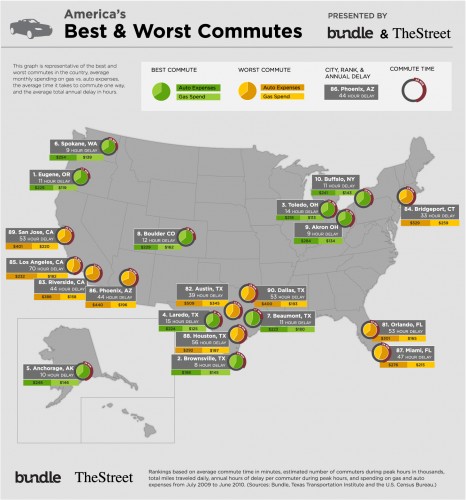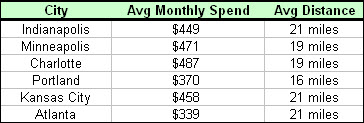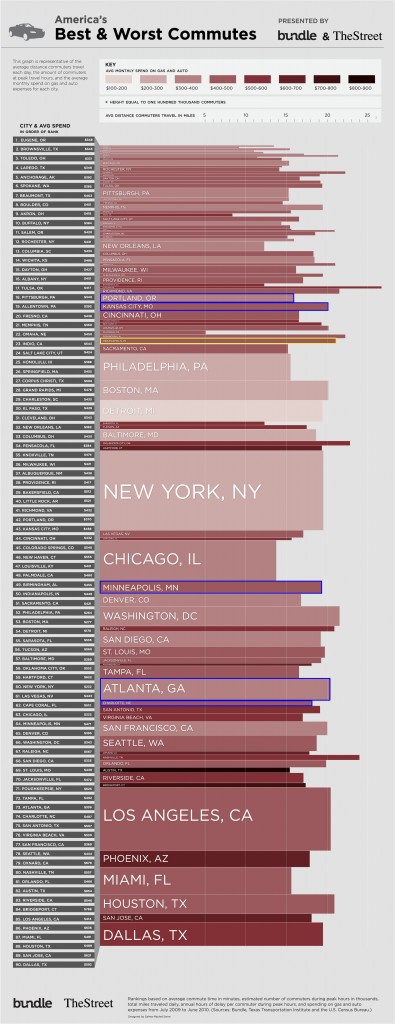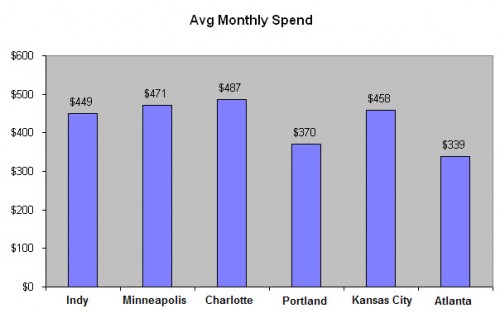
A recent study by Bundle & The Street, lends some credibility to the notion that purchasing a home in the suburbs based upon the premise that it’s “cheaper” may not really be that true at all. The study focused on a number of major and minor metro regions across the nation and pitted their daily commute times, distances and also added the metric averaging what a household might spend on transportation per month. The numbers paint a striking picture. A couple of infographics were released with the report that displayed some of the maximum and minimum commutes. You can peruse through the data for yourself if you are curious. It is quite striking the number of hours wasted in some places, and how many not wasted in others, when compared to Indianapolis.

If you travel in urban or transportation study circles, my post is late to the game. So I thought I would take this a step further, and compare Indianapolis, to a few of it’s peer cities; or as Brookings is now calling a group of these similar performers, “The New Heartland”. Brooking’s released a report recently called, “The State of Metropolitan America” and in it, examined how some metro areas are performing, or underperforming. A better definition can be taken directly from the report:
New Heartland metro areas are also fast growing, highly educated locales, but have lower shares of Hispanic and Asian populations than the national average. These 19 metro areas include many in the “New South” where blacks are the dominant minority group, such as Atlanta and Charlotte, as well as largely white metro areas throughout the Midwest and West, such as Indianapolis and Portland, OR
Aaron Renn, whom I consider one of the foremost authority on urban study, broke down the report a while back. It’s a great read if you have the time. Some of the cities that are classified as “New Heartland”, and whom I will be using for comparison in this analysis are Atlanta, Charlotte, Portland, Kansas City & Minneapolis. There is no basis for their selection except that they are New Heartland cities. The data was taken from this link that includes the data for all 90 cities examined.
If we look at the data presented for these cities, we can see that they perform as follows:

The first thing that jumps out, is that the typical commute distance is similar for all cities, despite a shorter distance for Portland. The next thing that grabs us, is the amount of money spent each month on automobile related expenses. The harder to capture metric, and what may bridge the link between the data and perception, is the following graphic. I have taken the 90 metro image, and highlighted the cities in focus. You can see that some cities have a “taller” bar than others. This indicates the amount of people on the region’s roadways at peak commuting times. I think this tells the story about cities like Atlanta who have a reputation of longer waiting times in traffic, but what is not really indicated on the table above.

Conclusions
In wrapping up, I thought that it would be interesting to contrast the transit systems provided by each of these cities. Indianapolis and Kansas City both lack any sort of rail transit system while the rest do. The cost data would suggest that Portland & Atlanta are cheaper places to commute. They do both have somewhat robust rail systems that afford passengers a hassle free commute to their respective region’s core. Minneapolis and Charlotte are both just entering this game while KC & Indy both still struggle to find the civic will to make this happen. Indy is by far the worst city on this list in terms of general public transit options. The fact that it lists the lowest amount of people on the road, yet one of the higher amounts of monthly spend, points to a larger dependence on the automobile to get to and from work; it is also, the longest commute distance of any of the cities examined.

What else can we say about the data provided here? From a shear cost comparison, Portland & Atlanta both look like nice places to move to should you want to spend less on commuting. However, Atlanta and Minneapolis both offer a seemingly frustrating drive due to the amount of people on the roads.
Locally, should Indianapolis continue to grow as the Brookings New Heartland typology suggests, commuting expenses could get worse as more people choose to live here. With the price of parking set to double in the next couple of years due to the recent parking meter lease, the monthly spend for people commuting to the downtown area only stands to increase. Coupled with the expected economic rebound, and oil prices being driven up, Indy commuters are looking down the barrel of monthly auto related spending north of $500 per household. To that end, these data points paint a pretty good picture for transit advocates.
This is only apples to apples if you count in the cost of commuting the taxes paid to support transit systems.
Also, I would look not just as commute distance, but also at commute time. Time is valuable.
Thanks for the kind words.
I thought about the time component, but I couldnt find the raw data used to compute those things. The “summary graphic” that they provided had the time wasted data point, but not how they computed this. It would have been nice to be able to do the math like they did for the cities I listed here.
One fallacy of these kinds of studies is that no one can give up a car completely, except in the most transit-dense US cities. Then one begins to trade lower commute expense for much higher housing expense.
.
But one could certainly reduce car expenses in Indy by cutting annual mileage in half, i.e. commuting to downtown from within the “old city”, even by car.
As for giving up the car completely…
I have an 8 mile commute to work (Broad RIpple to downtown). Most days this is done on bicycle. With icy roads, I take the city bus. When I want to leave town, I’ll take the the back roads on my Vespa to Chicago, Cincy, ect.
When I purchased my home, I intentionally selected this neighborhood because of it’s proximity to the bus, Monon trail and nearby shops.
I have not calculated the financial impact of being car free. But I am healthier and happier. I have no desire to own a car again.
I agree with AQuick, I live downtown and work in Avon and during the warmer months i rode the entire distance both ways, now i take indygo to the western edge and then drive, but if provided a clear route and proper clothing i could easily see myself riding all year! It is not impossible to live without the car, it just becomes a lifestyle choice many are not willing to face.
Do either of you take children to the doctor or to daycare, or take them to visit friends or relatives outside your local bubble? How safe is a child on a Vespa or in a bike seat?
Study is typical of number crunchers. Life is not statistics! Figure of $449 monthly car expense figure is way hyped up to make cars look bad. Do your own figures.
Suburbs offer green apace, gardens, yard for kids, neighborhood barbecues, relaxing life style, low crime, better schools, nicer local urban zones, (like Carmel in Indianapolis), movie theaters, better infrastructure not needing daily repair, nicer scenery other than brick canyons in the city, and a plethora of features that more than mitigate driving to downtown. Mega buses are an interesting alternative. Only .04 of Americans bike. Get over biking already. It’s for kids. Geez.
Car figures are false. Suburbs great. Trees, lawns, gardens, back yards,
garages, barbecues, friendly neighbors, which easily mitigate car issues.
No brick city canyons or constant infrastructure repair, noise and traffic.
Get over biking already. Only .04 Americans bike. Geez